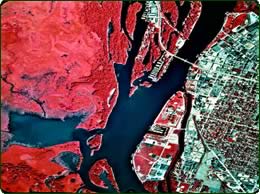|
- The Cartography and Geographic Information Systems labs-GIS
for short-make important contributions to the Center's mission.
The GIS products created in the labs are used by scientists
for modeling and analysis as well as by natural resource managers
to improve their decision making. Let's take a closer look
at the process from start to finish using land cover/land use
data of the Upper Mississippi River as an example. The process
begins by planning the course of an airplane with a special,
gyroscopically mounted camera. The camera produces 9"x9" color
infrared aerial photos that are then ground truthed to ensure
accuracy. Photo interpreters take these photos, and using fine-tipped
technical pens, delineate areas distinguished by similar vegetation
types such floodplain forest and aquatic vegetation. At this
point, the interpreted photos do not accurately reflect actual
locations and distances on a map. "Georeferencing" is
then done to transfer the data from the photos onto base maps
with accurate latitude and longitude information. To be useful,
the data has to be converted into a digital, computer-ready
format. This is the role of special, wide-format scanners.
 These
scanners take the overlays with the classification data and
convert them from a raster (dot-based) format to a vector (line
and shape-based) format. To complete this stage, the data undergoes
a rigorous Quality Assurance/Quality Control process. These
scanners take the overlays with the classification data and
convert them from a raster (dot-based) format to a vector (line
and shape-based) format. To complete this stage, the data undergoes
a rigorous Quality Assurance/Quality Control process.
- Once the data become electronic, things really start to get
interesting. This is the GIS lab. Here, the data is further
checked and manipulated. It is then entered into a massive
set of databases that contain layer upon layer of information.
While we have only been collecting aerial photos for the past
15 years, we still can get a good picture of what the river
landscape was like over 150 years ago. Courtesy of engineers
who surveyed the river in the early 1820s, we have a collection
of detailed General Land Office maps that have been digitized
and entered into the Center's GIS. We can now see how the river
landscape might have looked before settlement. We can also
see how the building of the locks and dams in the 1930s have
dramatically altered the river ecosystem. What you see here
is an example of what the GIS software can do. This is an 3-D
animation of Pool 8 compiled from many aerial photos. Recent
examples of how GIS tools have been used include their use
in radiotelemetry tracking of paddlefish and their use by the
Fish and Wildlife Service to set voluntary avoidance areas
around migratory bird areas on Lake Onalaska.
|